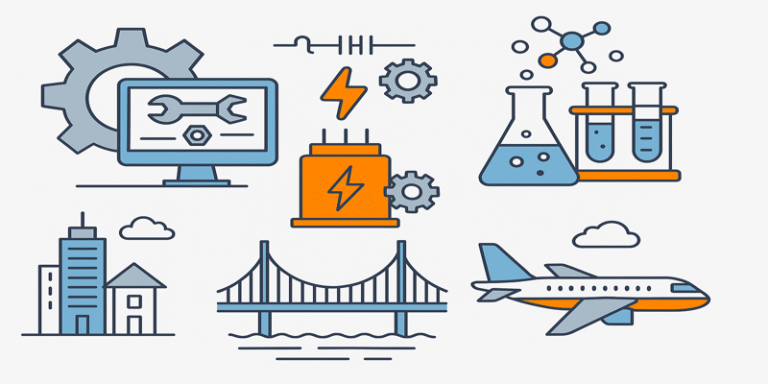Engineering and Technology are at the heart of modern civilisation. They represent the integration of scientific knowledge, mathematics, and creativity to design, build, and maintain machines, systems, and structures that meet human needs. From the bridges that connect communities to the aircraft that shrink global distances, and from computer systems that process vast amounts of data to biomedical devices that save lives, engineering is the discipline that transforms theory into tangible products (Beer et al., 2018).
Engineering is a vast field with multiple specialisations. This article explores five major branches: Mechanical Engineering, Electrical and Electronic Engineering, Chemical Engineering, Civil Engineering, and Aerospace Engineering.
1.0 Mechanical Engineering
Mechanical engineering is one of the oldest and broadest branches of engineering. It deals with the design, analysis, and manufacture of mechanical systems, drawing on principles of mechanics, thermodynamics, fluid dynamics, and materials science.
Mechanical engineers work on projects ranging from automotive engines and robotics to renewable energy systems and industrial machinery. The discipline involves understanding how forces and motion affect physical systems and how to optimise them for efficiency and durability (Shigley et al., 2020).
Core study areas include:
- Dynamics and control systems
- Heat transfer and thermodynamics
- Computer-aided design (CAD)
- Manufacturing processes
- Mechatronics
Applications are extensive: designing wind turbines, creating prosthetic limbs, developing HVAC systems, and advancing automation in manufacturing. With the rise of Industry 4.0, mechanical engineers are also integrating artificial intelligence and smart sensors into traditional systems.
2.0 Electrical and Electronic Engineering
Electrical and electronic engineering focuses on the study and application of electricity, electromagnetism, and electronics. Electrical engineering traditionally deals with large-scale systems such as power generation, transmission, and distribution, while electronic engineering concentrates on small-scale systems like circuits, microprocessors, and semiconductors.
Key topics include:
- Circuit theory
- Power systems
- Signal processing
- Control systems
- Embedded systems
This field has enabled the development of smart grids, electric vehicles, wireless communications, and renewable energy technologies. As Chen et al. (2017) note, electrical engineers are at the forefront of the global transition towards sustainable energy solutions, such as solar and wind power, integrated with energy storage systems.
From MRI machines in hospitals to navigation systems in aircraft, electrical and electronic engineering powers both our infrastructure and our personal devices.
3.0 Chemical Engineering
Chemical engineering applies the principles of chemistry, physics, biology, and engineering to transform raw materials into valuable products in a safe, sustainable, and cost-effective way. It deals with the design and operation of processes that produce fuels, chemicals, pharmaceuticals, and materials.
Core areas include:
- Process design and optimisation
- Reaction engineering
- Transport phenomena
- Separation processes
- Biochemical engineering
Chemical engineers work in industries as diverse as petrochemicals, food processing, water treatment, biotechnology, and energy. For example, they design processes for producing vaccines, refining crude oil, and manufacturing polymers for packaging and construction.
Sinnott and Towler (2020) highlight that modern chemical engineering increasingly emphasises green chemistry and sustainable process design, reducing environmental impact through innovations like carbon capture and bio-based fuels.
4.0 Civil Engineering (Built or Construction Engineering)
Civil engineering is responsible for the planning, design, construction, and maintenance of the infrastructure that supports daily life. This includes roads, bridges, buildings, dams, airports, and water supply systems.
Core sub-disciplines include:
- Structural engineering – ensuring that structures can withstand loads and stresses.
- Geotechnical engineering – studying soil and rock mechanics for foundations.
- Transportation engineering – designing efficient and safe transport networks.
- Hydraulic and environmental engineering – managing water resources and minimising environmental impact.
Civil engineers must balance functionality, safety, cost, and sustainability. According to Mamlouk and Zaniewski (2019), modern civil engineering increasingly incorporates sustainable materials, energy-efficient designs, and resilient infrastructure to withstand climate-related challenges.
Examples range from designing earthquake-resistant skyscrapers in Japan to developing flood defences in the Netherlands.
5.0 Aerospace Engineering
Aerospace engineering focuses on the design, development, and testing of aircraft, spacecraft, and related systems. It combines elements of mechanical engineering, materials science, electronics, and computer science.
Aerospace engineers work in two main areas:
- Aeronautical engineering – dealing with flight within the Earth’s atmosphere.
- Astronautical engineering – concerned with spacecraft and exploration beyond Earth.
Key study areas include:
- Aerodynamics
- Propulsion systems
- Flight mechanics
- Avionics
- Spacecraft systems engineering
Applications extend from commercial airliners and military jets to satellites, space probes, and space stations. Sutton and Biblarz (2016) note that aerospace engineers are now driving innovation in hypersonic flight, electric propulsion, and reusable space vehicles, such as those pioneered by SpaceX.
This field plays a crucial role in defence, communications, global transportation, and space exploration.
Interconnectedness of Disciplines
While these five branches have distinct focuses, modern engineering is increasingly interdisciplinary. For instance:
- Developing an electric aircraft involves mechanical engineers for structural design, electrical engineers for propulsion systems, and aerospace engineers for aerodynamic optimisation.
- Creating a sustainable chemical plant requires chemical engineers for process design, civil engineers for facility construction, and electrical engineers for power systems.
Technology integration—such as automation, artificial intelligence, and data analytics—is now a common thread across all engineering disciplines.
The Role of Technology in Modern Engineering
Technology accelerates innovation in engineering by enabling:
- Computer-aided design (CAD) and simulation to test ideas virtually before building.
- Additive manufacturing (3D printing) to create prototypes and complex parts quickly.
- Sensor networks and IoT for real-time monitoring of systems.
- Machine learning to optimise designs and predict system failures.
These advancements not only enhance productivity but also reduce costs and environmental impacts, making engineering solutions more sustainable.
Engineering and Technology are powerful drivers of societal progress, combining scientific understanding with practical ingenuity. The branches of mechanical, electrical and electronic, chemical, civil, and aerospace engineering each contribute uniquely to building the world we live in—while increasingly working together to solve global challenges.
As industries embrace digital transformation and prioritise sustainability, engineers will remain at the forefront of innovation, shaping everything from our cities to our journeys into space. For aspiring engineers, mastering both technical skills and creative problem-solving will be the key to contributing meaningfully to a rapidly evolving world.
References
Beer, F. P., Johnston, E. R., DeWolf, J. T. & Mazurek, D. F. (2018). Mechanics of Materials (8th ed.). McGraw-Hill Education.
Chen, P., Irwin, G. W. & McLoone, S. (2017). “Electrical Engineering: A Foundation for the Future Energy Transition.” Renewable Energy, 113, pp. 1–9.
Mamlouk, M. S. & Zaniewski, J. P. (2019). Materials for Civil and Construction Engineers (4th ed.). Pearson.
Shigley, J. E., Uicker, J. J. & Pennock, G. R. (2020). Shigley’s Mechanical Engineering Design (11th ed.). McGraw-Hill Education.
Sinnott, R. K. & Towler, G. (2020). Chemical Engineering Design (6th ed.). Elsevier.
Sutton, G. P. & Biblarz, O. (2016). Rocket Propulsion Elements (9th ed.). Wiley.









